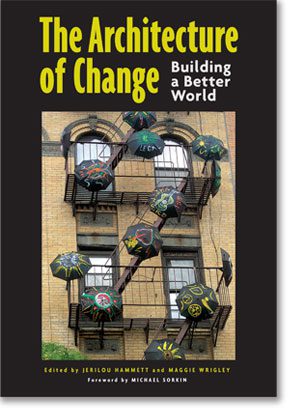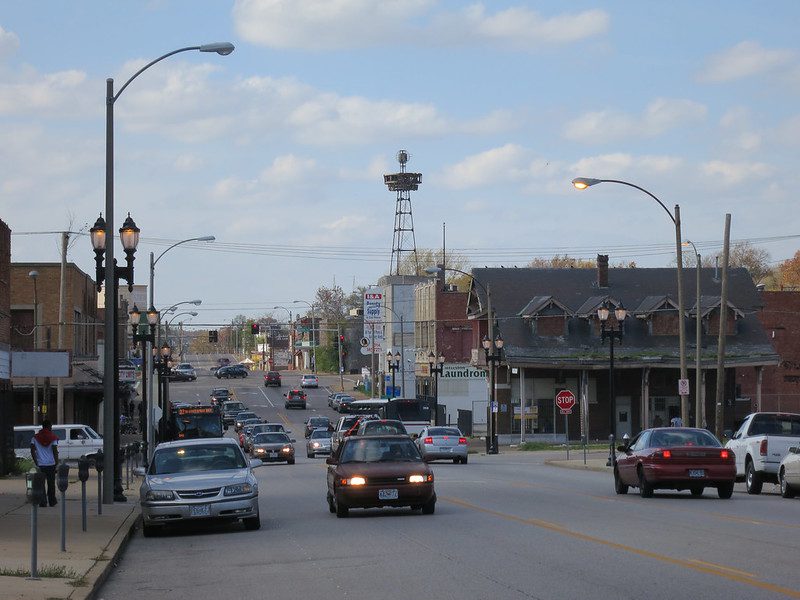The Architecture of Change: Building a Better World is a homage by Jerilou Hammett to her late husband, the writer, journalist, and social activist Kingsley Hammett, who died unexpectedly in 2008. It is an altogether fitting tribute, for in reminding us of Kingsley’s humanity it also spotlights his skill as a reporter and writer. The book consists of 36 articles gleaned from the pages of DESIGNER/builder magazine, the ambitious publication that Kingsley and Jerilou produced for fifteen years starting in 1994. It was a two-person operation—published and largely written by Kingsley and edited by Jerilou, who has assembled the present anthology, together with Maggie Wrigley.
The Architecture of Change documents efforts by community-based individuals and organizations, sometimes assisted by design professionals, to change the world, for that was the unabashed project of DESIGNER/builder. Although the book is composed of discrete chapters, each chronicling a particular project or, in some cases, personal profile, the cumulative weight of the volume goes beyond the anecdotal and episodic to create a rich picture of the theory, history and practice of grassroots activism, touching, along the way, on matters of art, education, housing, aging, accessibility, planning, health, economics and nutrition. It is the combination of facts on the ground with the human element—the essence of good journalism—that makes the stories come alive. Kingsley Hammett was a very good writer, and the book, in addition to being informative and provocative, is a pleasure to read.
The heroes of these stories are not the architects, planners, and landscape architects who figure in many of them, but the larger community efforts of which they are part. In this sense it presents the converse side of the exhibit “Small Scale, Big Change: New Architecture of Social Engagement” at the Museum of Modern Art in 2010-2011, which focused precisely on the role of the architects and their creations as catalysts of change. Here the target is the base, the popular movements that have the power to transform lives locally in ways that are replicable and, in some instances, scalable to wider applications. While some of these popular movements are linked to well established technical assistance or community development organizations like New York’s UHAB (Urban Homesteading Assistance Board) or Enlace Chicago(formerly Little Village CDC in Chicago), more often than not the organizations are small scale local efforts, led by community organizers, community gardeners, artists, and educators.
The articles are striking both for their geographic reach and their immediacy. The chapters take us from street furniture and grocery vans in West Oakland to a hip-hop high school in St. Paul, to a variety of stories in New York City with stops along the way in Santa Monica, Chicago, Kansas City, Philadelphia, Washington DC, Richmond, Va., and Trenton. International stories include interfaith community building in El Salvador, a children’s playground in Thailand, housing construction in Afghanistan, design/build in Mexico, and the galvanizing potential of art in a squatter settlement outside Nairobi. Each of these stories is rendered with a keen eye for detail, a remarkable feat given that the authors did all their writing from their base in Santa Fe. The secret of the intimacy of these accounts is the careful preparation in locating key people to talk to and then cultivating a relationship with them through many phone conversations before framing the story and asking the most germane questions. (I know this first hand as the subject of a profile in the magazine in 2000).
The focus on place-specific, grassroots efforts is balanced by a series of in-depth profiles that also focus more on issues. “The Evolution of Universal Design,” for example, traces the pioneering work of Elaine Ostroff in this field. Starting with questions about the impact of physical design in learning environments for children with developmental disabilities, she extended this inquiry into a broader concern for people with other disabilities in the general population, a field that has come to be known as universal access or universal design. The subject of universal design is also the focus of a profile of Patricia Moore, a gerontologist/sociologist who went underground (in disguise) to experience firsthand the treatment of the aging and to bring these findings to the attention of her sometimes tone-deaf colleagues. Indeed, aging, along with various housing issues, receives a particular emphasis in this volume, with four separate articles devoted to it. (Housing receives the most attention with eight.)
Sometimes the articles yield unexpected rewards. For example, the interview with Fredda Vladeck, conducted jointly by Jerilou and Kingsley, is centered on her work in establishing programs in New York City to assist seniors who are aging in place; that is, staying in their long-time residences as they age rather than retiring elsewhere, a phenomenon known as NORCs (Naturally Occurring Retirement Communities). Working initially at Penn South Mutual Housing Corporation, a union-sponsored limited equity housing development just south of Penn Station in New York, Vladeck found an enthusiastic ally in David Smith, the longtime president of the cooperative. Together they crafted a program which became a model not only for New York City, but one that was duplicated across the country. The unexpected nugget is that Fredda Vladeck was related through marriage to Baruch Vladeck, an early housing advocate who, in her recollection, convinced Mayor Fiorello LaGuardia to go to Washington to persuade President Roosevelt to fund public housing in New York City, the forerunner of the national program. Thus an article about seniors aging in place suddenly connects us to origins of public housing in New York and the nation.
This topic recurs in one of the most compelling articles in the collection, the story of the founding of the National Museum of Public Housing in Chicago. The museum is the brainchild of Deverra Beverly, a longtime public housing resident who was president of the tenants’ council at ABLA Homes and a commissioner on the Chicago Housing Authority. The goal of the museum is to disprove the notion that public housing was a failure, and especially not a failure on the part of the residents, as it is often portrayed. Beverly describes the rich sense of community that imbued public housing in the early days, before mismanagement, policy changes, and drugs ripped the heart out of the enterprise. As she says, “Without this museum we’ll have grandchildren and great-grandchildren who never know that public housing existed in any meaningful form.” The article contains extended comments by Roberta Feldman, an architect and educator who has worked with the women in Chicago’s public housing for a long time. The narrative highlights the intelligence, ingenuity and perseverance of these women, providing along the way a capsule history of public housing. It is an example of both the reach of these articles and the way in which people of color are given foreground treatment in their pages. The focus on Ms. Beverley will remain as a tribute, as she died in November 2013.
Beyond the geographical diversity and human intimacy of these stories is the link they make between theory and practice, although the connection is not always explicit. This is journalism, after all, not academic discourse or professional jargon. For example, the lead article in the collection, “Sidewalk Living Rooms,” describes how street furniture in West Oakland both accommodates and makes visible the working class Latino population of the neighborhood so that, as Hammett succinctly observes, “neighbors can claim their right to public space while at the same time discouraging those who would like to see them gone altogether.” Some readers will hear echoes of “the right to the city” whether their point of reference is Henri Lefebvre, David Harvey, or the current Right to the City movement.
This is one of several articles that address, in various forms, the “two cities” tendency that was the focus of Mayor Bill de Blasio’s recent successful election campaign in New York City. Two articles focus on opposition by planners and activists in Toronto to a master plan aimed at intensification of the city center to attract the “creative class.” This put them at odds with local icon Jane Jacobs, who backed the plan. As urban geographer/planner Deborah Cowen notes, “In some ways it can be difficult to distinguish within the urban planning community between a gentrifying impulse and a social impulse because they are so entwined here due to Jacobs’ legacy.” The contradictions posed by increased economic equality, expressed by rapidly gentrifying neighborhoods in the face of high levels of poverty, unemployment and homelessness, will be familiar to neighborhood activists in many cities. This represents the continued playing out of the “dual cities” phenomenon identified two decades ago by Saskia Sassen, Manuel Castells and others.
Sometimes these theoretical underpinnings are referenced directly in the stories at hand, as in the case of David Ellis and the High School for the Recording Arts in St. Paul, which draws on the multiple intelligence theories of Howard Gardner to create new avenues for motivating and educating urban youth. Here, young people’s immersion in pop music culture becomes the springboard for an innovative curriculum that incorporates a wide range of learning modes (verbal, logical/mathematical, musical, interpersonal, spatial, etc.). But familiarity with theoretical writings is not necessary for an understanding of the thrust of these stories, and that is the great accomplishment of the book. The stories speak for themselves, without need of academic undergirding or editorializing.
Jerilou and Kingsley Hammett shared a goal: “building a better world.” Their vehicles in this quest are the people slugging it out in the trenches, making a difference in their communities and neighborhoods. The stories they report are inspirational, often the last bastions against the onslaught of global capitalism that holds sway both at home and abroad. They provide glimmers of optimism for those trying to link local struggles to national movements capable of bringing the systemic change that can create a societal framework worthy of these efforts.
An earlier version of this review was published in Progressive Planning, The Magazine of the Planners Network, No. 198, Winter 2014.






Comments